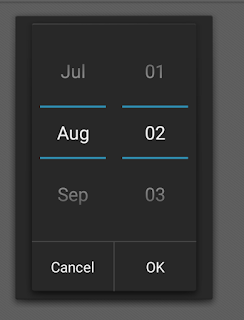Uber Like Map in Android
Step 1: Create Google Map Api Key
If you are not able how to create Api key for Google map in android then follow the bellow steps .
a) Go to console using this link https://console.developers.google.com
b) click on create project menu from select a project menu .
Put base package and SHA1 finger print for create api key for Google map . Copy base package name from manifest file and SHA1 print from eclipse > window>preferences>android>build> SHA1 finger print . click in create button .
Step 2: add Google play service in project .
Eclipse :
Eclipse :
Right click on project> properties>android>add(Library section)
Android Studio :
Open build.gradle > add given bellow lines
compile 'com.google.android.gms:play-services-location:9.0.0' compile 'com.google.android.gms:play-services-maps:9.0.0'
compile 'com.google.android.gms:play-services-base:9.0.0'
> Sync the gradle file . Like this
dependencies {
compile fileTree(include: ['*.jar'], dir: 'libs')
compile 'com.android.support:design:23.4.0' compile 'com.android.support:appcompat-v7:23.4.0'
compile 'com.google.android.gms:play-services-location:9.0.0' compile 'com.google.android.gms:play-services-maps:9.0.0'
compile 'com.google.android.gms:play-services-base:9.0.0'
}
If Gradle doesn’t automatically ask you to sync your project, open module 'app' from the Build menu or press F9. By doing so, the Android Studio build system will automatically fetch the necessary resources and you will be able to import any required classes.
Step 3: Manifest file :
<?xml version="1.0" encoding="utf-8"?>
<manifest xmlns:android="http://schemas.android.com/apk/res/android"
package="--- your package name ----"
android:versionCode="1"
android:versionName="1.0" >
<uses-sdk
android:minSdkVersion="11"
android:targetSdkVersion="21" />
<uses-feature
android:glEsVersion="0x00020000"
android:required="true" />
<uses-permission android:name="android.permission.INTERNET" />
<uses-permission android:name="android.permission.ACCESS_NETWORK_STATE" />
<uses-permission android:name="android.permission.WRITE_EXTERNAL_STORAGE" />
<!--
The following two permissions are not required to use
Google Maps Android API v2, but are recommended.
-->
<uses-permission android:name="android.permission.ACCESS_COARSE_LOCATION" />
<uses-permission android:name="android.permission.ACCESS_FINE_LOCATION" />
<application
android:allowBackup="true"
android:icon="@drawable/ic_launcher"
android:label="@string/app_name"
android:theme="@style/AppTheme" >
<activity
android:name=".UberLikeMap"
android:label="@string/app_name"
android:screenOrientation="portrait" >
<intent-filter>
<action android:name="android.intent.action.MAIN" />
<category android:name="android.intent.category.LAUNCHER" />
</intent-filter>
</activity>
<meta-data
android:name="com.google.android.gms.version"
android:value="@integer/google_play_services_version" />
<meta-data
android:name="com.google.android.maps.v2.API_KEY"
android:value="---- your api key-----------" />
</application>
</manifest>
Step 4: Layout File (Design)
<RelativeLayout xmlns:android="http://schemas.android.com/apk/res/android"
xmlns:tools="http://schemas.android.com/tools"
android:layout_width="match_parent"
android:layout_height="match_parent" >
<fragment
android:id="@+id/uber_map"
android:name="com.google.android.gms.maps.MapFragment"
android:layout_width="match_parent"
android:layout_height="match_parent" />
<TextView
android:id="@+id/uber_tvAddress"
android:layout_width="match_parent"
android:layout_height="wrap_content"
android:background="#FFFFFF"
android:padding="5dp"
android:text=""
android:textColor="#000000" />
<ImageView
android:layout_width="wrap_content"
android:layout_height="wrap_content"
android:layout_centerInParent="true"
android:adjustViewBounds="true"
android:background="@drawable/custom_location"
android:contentDescription="@string/app_name" />
</RelativeLayout>
Step 5: Code
package com.example.mapdemo;
import java.io.IOException;
import java.util.List;
import com.google.android.gms.common.ConnectionResult;
import com.google.android.gms.common.api.GoogleApiClient;
import com.google.android.gms.common.api.GoogleApiClient.ConnectionCallbacks;
import com.google.android.gms.common.api.GoogleApiClient.OnConnectionFailedListener;
import com.google.android.gms.location.LocationListener;
import com.google.android.gms.location.LocationRequest;
import com.google.android.gms.location.LocationServices;
import com.google.android.gms.maps.CameraUpdateFactory;
import com.google.android.gms.maps.GoogleMap;
import com.google.android.gms.maps.GoogleMap.OnCameraChangeListener;
import com.google.android.gms.maps.MapFragment;
import com.google.android.gms.maps.OnMapReadyCallback;
import com.google.android.gms.maps.model.BitmapDescriptorFactory;
import com.google.android.gms.maps.model.CameraPosition;
import com.google.android.gms.maps.model.LatLng;
import com.google.android.gms.maps.model.Marker;
import com.google.android.gms.maps.model.MarkerOptions;
import android.app.Activity;
import android.content.Context;
import android.location.Address;
import android.location.Geocoder;
import android.location.Location;
import android.os.AsyncTask;
import android.os.Bundle;
import android.util.Log;
import android.widget.TextView;
public class UberLikeMap extends Activity implements LocationListener,ConnectionCallbacks,OnConnectionFailedListener,OnMapReadyCallback{
Context mContext;
TextView tvAddress;
private GoogleApiClient mGoogleApiClient=null;
private static final LocationRequest REQUEST = LocationRequest.create()
.setInterval(5000)
.setFastestInterval(16)
.setPriority(LocationRequest.PRIORITY_HIGH_ACCURACY);
// Google Map
private GoogleMap googleMap;
MapFragment mapFragment;
Marker markerCurre=null;
@Override
protected void onCreate(Bundle savedInstanceState) {
super.onCreate(savedInstanceState);
setContentView(R.layout.activity_uber_app_map_demo);
mContext=this;
mapFragment = ((MapFragment)getFragmentManager().findFragmentById(R.id.uber_map));
tvAddress=(TextView)findViewById(R.id.uber_tvAddress);
mapFragment.getMapAsync(this);
mGoogleApiClient = new GoogleApiClient.Builder(mContext)
.addApi(LocationServices.API)
.addConnectionCallbacks(this)
.addOnConnectionFailedListener(this)
.build();
}
@Override
public void onPause() {
super.onPause();
if(mGoogleApiClient!=null)
{
mGoogleApiClient.disconnect();
}
}
@Override
public void onResume() {
super.onResume();
if(mGoogleApiClient!=null)
{
mGoogleApiClient.connect();
}
}
@Override
public void onLocationChanged(Location loc) {
// TODO Auto-generated method stub
if (loc == null)
return;
if (markerCurre == null) {
markerCurre = googleMap.addMarker(new MarkerOptions()
.flat(true)
.icon(BitmapDescriptorFactory.fromResource(R.drawable.droplocation_icon))
.title("Your Current Position")
.anchor(0.5f, 0.5f)
.position(new LatLng(loc.getLatitude(), loc.getLongitude())));
googleMap.moveCamera(CameraUpdateFactory.newLatLngZoom(new LatLng(loc.getLatitude(), loc.getLongitude()),16.0f));
}
}
@Override
public void onConnected(Bundle arg0) {
// TODO Auto-generated method stub
LocationServices.FusedLocationApi.requestLocationUpdates(
mGoogleApiClient,
REQUEST,
this); // LocationListener
}
@Override
public void onConnectionSuspended(int arg0) {
// TODO Auto-generated method stub
}
@Override
public void onConnectionFailed(ConnectionResult arg0) {
// TODO Auto-generated method stub
}
@Override
public void onMapReady(GoogleMap map) {
// TODO Auto-generated method stub
this.googleMap=map;
googleMap.setMyLocationEnabled(true);
googleMap.setMapType(GoogleMap.MAP_TYPE_NORMAL);
//googleMap.getUiSettings().setRotateGesturesEnabled(false);
googleMap.setOnCameraChangeListener(new OnCameraChangeListener() {
@Override
public void onCameraChange(CameraPosition position) {
// TODO Auto-generated method stub
Log.w(""+position.target.latitude, ""+position.target.longitude);
new ReverseGeocodingTask().execute(position.target);
}
});
}
private class ReverseGeocodingTask extends AsyncTask<LatLng, Void, String>{
double _latitude,_longitude;
@Override
protected String doInBackground(LatLng... params) {
Geocoder geocoder = new Geocoder(mContext);
_latitude = params[0].latitude;
_longitude = params[0].longitude;
List<Address> addresses = null;
String addressText="";
try {
addresses = geocoder.getFromLocation(_latitude, _longitude,1);
} catch (IOException e) {
e.printStackTrace();
}
if(addresses != null && addresses.size() > 0 ){
Address returnedAddress = addresses.get(0);
StringBuilder strReturnedAddress = new StringBuilder("");
for (int i = 0; i < returnedAddress.getMaxAddressLineIndex(); i++) {
if(returnedAddress.getMaxAddressLineIndex()==(i-1))
{
strReturnedAddress.append(returnedAddress.getAddressLine(i));
}
else
{
strReturnedAddress.append(returnedAddress.getAddressLine(i)).append(",");
}
}
addressText = strReturnedAddress.toString();
Log.w("My Current loction address", "" + strReturnedAddress.toString());
}
return addressText;
}
@Override
protected void onPostExecute(String addressText) {
final String result=addressText;
runOnUiThread(new Runnable() {
@Override
public void run() {
// TODO Auto-generated method stub
tvAddress.setText(result);
}
});
}
}
}
Output :











Comments
Post a Comment